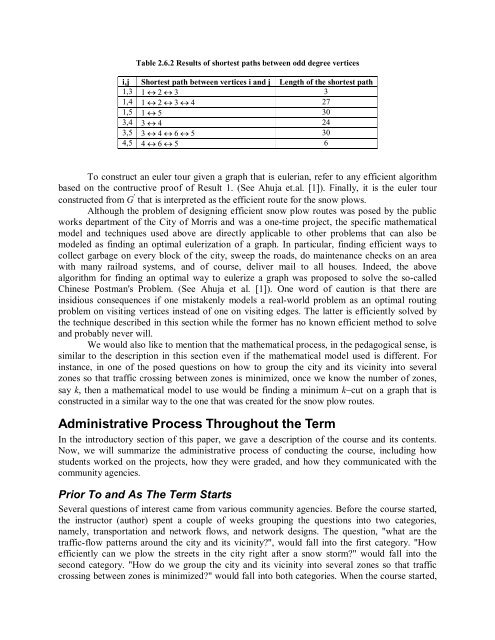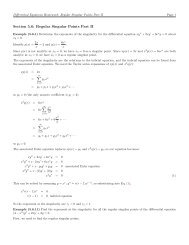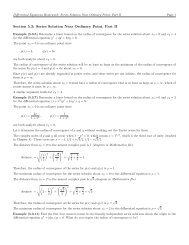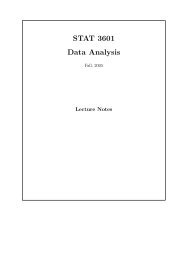Designing Efficient Snow Plow Routes - University of Minnesota
Designing Efficient Snow Plow Routes - University of Minnesota
Designing Efficient Snow Plow Routes - University of Minnesota
Create successful ePaper yourself
Turn your PDF publications into a flip-book with our unique Google optimized e-Paper software.
Table 2.6.2 Results <strong>of</strong> shortest paths between odd degree vertices<br />
i,j Shortest path between vertices i and j Length <strong>of</strong> the shortest path<br />
1,3 1 2 3 3<br />
1,4 1 2 3 4 27<br />
1,5 1 5 30<br />
3,4 3 4 24<br />
3,5 3 4 6 5 30<br />
4,5 4 6 5 6<br />
To construct an euler tour given a graph that is eulerian, refer to any efficient algorithm<br />
based on the contructive pro<strong>of</strong> <strong>of</strong> Result 1. (See Ahuja et.al. [1]). Finally, it is the euler tour<br />
constructed from G that is interpreted as the efficient route for the snow plows.<br />
Although the problem <strong>of</strong> designing efficient snow plow routes was posed by the public<br />
works department <strong>of</strong> the City <strong>of</strong> Morris and was a one-time project, the specific mathematical<br />
model and techniques used above are directly applicable to other problems that can also be<br />
modeled as finding an optimal eulerization <strong>of</strong> a graph. In particular, finding efficient ways to<br />
collect garbage on every block <strong>of</strong> the city, sweep the roads, do maintenance checks on an area<br />
with many railroad systems, and <strong>of</strong> course, deliver mail to all houses. Indeed, the above<br />
algorithm for finding an optimal way to eulerize a graph was proposed to solve the so-called<br />
Chinese Postman's Problem. (See Ahuja et al. [1]). One word <strong>of</strong> caution is that there are<br />
insidious consequences if one mistakenly models a real-world problem as an optimal routing<br />
problem on visiting vertices instead <strong>of</strong> one on visiting edges. The latter is efficiently solved by<br />
the technique described in this section while the former has no known efficient method to solve<br />
and probably never will.<br />
We would also like to mention that the mathematical process, in the pedagogical sense, is<br />
similar to the description in this section even if the mathematical model used is different. For<br />
instance, in one <strong>of</strong> the posed questions on how to group the city and its vicinity into several<br />
zones so that traffic crossing between zones is minimized, once we know the number <strong>of</strong> zones,<br />
say k, then a mathematical model to use would be finding a minimum kcut on a graph that is<br />
constructed in a similar way to the one that was created for the snow plow routes.<br />
Administrative Process Throughout the Term<br />
In the introductory section <strong>of</strong> this paper, we gave a description <strong>of</strong> the course and its contents.<br />
Now, we will summarize the administrative process <strong>of</strong> conducting the course, including how<br />
students worked on the projects, how they were graded, and how they communicated with the<br />
community agencies.<br />
Prior To and As The Term Starts<br />
Several questions <strong>of</strong> interest came from various community agencies. Before the course started,<br />
the instructor (author) spent a couple <strong>of</strong> weeks grouping the questions into two categories,<br />
namely, transportation and network flows, and network designs. The question, "what are the<br />
traffic-flow patterns around the city and its vicinity?", would fall into the first category. "How<br />
efficiently can we plow the streets in the city right after a snow storm?" would fall into the<br />
second category. "How do we group the city and its vicinity into several zones so that traffic<br />
crossing between zones is minimized?" would fall into both categories. When the course started,













